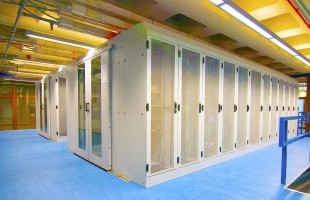SURF and Nikhef have established a new data connection with accelerator lab CERN in Geneva, which can transmit up to 400 Gigabits per second. That is four times faster than the best networks now and also the fastest international data line in the world.
The connection to CERN runs over SURF’s existing glass fiber, which already exists for 100 Gbit/s. The different bit rates are transmitted at different colors of light and broken down again at the receiver.
Last year, the high speed techniques used were successfully tested on a ring network in the Randstad, from Amsterdam via Utrecht and Delft to Leiden and back. The signal enters the fiber optic network via a switch at Amsterdam Science Park and is received again at Nikhef.
Data transport at 400 Gbit/s means sending the information content of about twelve full DVDs per second.
Signal loss
That is no small thing, says IT architect Tristan Suerink of Nikhef. At a high data rate of 400 Gigabits per second, all glass fibers and connections have to be super clean, otherwise there will be too much noise and signal loss. With 10 Gbit/s, you can still clean the fiber by wiping it on your pants. That’s really not enough here.
In the light line, as little connector connection as possible is left, to avoid losses. Transitions are all welded. In addition, Raman amplifiers have been placed along the way to maintain the signal level. The techniques used have been developed in recent years at SURF and Nikhef and intensively tested.
To generate the large amount of data for the tests, Nikhef previously built a data cannon that can send a billion packets of 64 bytes per second. Meanwhile, there are still two systems that can generate 400 Gbit/s of data traffic.
Tidal wave
Particle physicists don’t really need such data rates right now. The new connection mainly takes an advance on the tidal wave of measurement data that CERN will provide in a few years’ time, when the LHC accelerator starts shooting protons at each other with even higher intensity. This High Luminosity LHC is expected to come into operation around 2027.
That seems far away, but according to Suerink, it is extremely important to have the data infrastructure ready on time. This is early and new technology, and with it you always have hassle.
Nikhef is one of the thirteen so-called Tier-1 nodes for CERN’s measurement data, where data is stored and made available to researchers. SURF is the collaboration of Dutch universities and colleges of higher education in the field of ICT.
More technical details about the new data connection can be found on the website tweakers.net.
